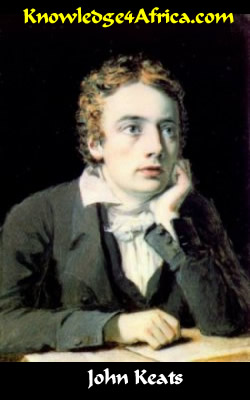|
READ THIS
"To Autumn" is regarded as Keats's best poem, written with graphic clarity just before his death.
He personifies the season, dressed in its rich autumn colours and alive with life and mellow vibrancy.
Everything is maturing now.
The fruits on the trees are at their sweetest, the wine is oozing with heady tranquillity. Everywhere the
birds and the insects are enriching the countryside with their melody.
 ABOUT THE POET
ABOUT THE POET
John Keats was born in London in 1795, the son of a hostler. Both his parents died while he was still
young -- his mother of tuberculosis. He was thereafter brought up by his grandmother who quickly made
him an apprentice physician.
He was still only in his late teens when he discovered that he too had caught TB and his younger brother
who was in his care soon died of it. In order to escape the disease, Keats moved to the sunnier and drier
climate of Italy.
There was no escape for him, however, and the poet died in 1821. He was then just 25 years of age. He
nevertheless bequeathed us a gargantuan amount of poetry written with an amazing maturity for one so
young.
Keats wrote this Ode one autumn evening in 1819. It has been said that he could not focus on his writing
because somebody nearby was disturbing his thoughts by practising on the violin. The poet went out for
a walk and, inspired by the autumn atmosphere, returned to write this poem.
Have you looked at the questions
in the right column?
|
TEST YOURSELF!
Read the left column and then answer
the following questions:
"Where are the songs of Spring? Ay, where are they?
Think not of them, thou hast thy music too."
- Why should the poet suddenly think of Spring? (2)

[Need help?]
Spring is usually regarded as the best season. Everything is in full growth. All is green. The winter is
over. The heat of summer has not yet arrived.
|
- The poet speaks in this stanza of the music of Autumn. What hints does he give as to this
music? (5)

[Need help?]
- "barréd clouds" -- music is written in bars;
- "with treble soft" -- musical term;
|
- Why does the poet describe the plains as "stubble-plains with rosy hue"? (4)

[Need help?]
The "plains" or fields have been reaped. The grain stalks are now no more than stubble. But,
unlike the full growth of grain which is yellow, the stubble has a hue of red about it and therefore presents
a "rosy" or red hue.
|
"Then in a wailful choir the small gnats mourn."
- What is meant by onomatopoeia? (2)

[Need help?]
Onomatopoeia is a word which sounds like the noise it is depicting: "buzzing" of the bees;
"croaking" of the frogs.
|
- Comment on the poet's use of onomatopoeia in this line. (4)

[Need help?]
There are two words in this line which are onomatopoeic: "wailful" and "mourn".
The poet uses these words to create a sound picture of what he is describing in words, namely the high-
pitched noise of the gnats which creates the impression of sadness or mourning.
|
- Can you find other examples of onomatopoeia in this stanza? (4)

[Need help?]
Is not the word "gnats" also onomatopoeic -- a word which sounds not unlike the irritating noise
that these little creatures make?
What about "bleat" being the noise that lambs make? "Sing", "whistles" and
"twitter" -- are these words not "onomatopoeic"?
|
"And full-grown lambs loud bleat from hilly bourn."
- What is alliteration? (2)

[Need help?]
Alliteration is the repetition of a consonant. It is used mostly for poetic effect -- i.e. it simply
sounds good to use alliteration. Sometimes, however, it might also be used to create an image of anger,
compassion, fear, etc.
|
- In what way has alliteration been used in this line? (2)

[Need help?]
The "b" has been repeated in "bleat" and "bourn".
|
GENERAL QUESTIONS:
Each stanza in this poem contains a different theme. Can you identify them? (3)

[Need help?]
Stanza 1 dwells on the fruitfulness of autumn: the swelling fruit and the blossoming flowers.
Stanza 2 focusses upon the sleepiness or laziness of autumn.
Stanza 3 speaks of the music and sounds of autumn.
|
What is an Ode? In what way can this poem be described as an Ode? (4)

[Need help?]
An Ode has been described as "a lyric poem, usually addressing a particular person or
thing".
It was a form of verse well used in Ancient Greece where it was either accompanied by a musical
instrument -- such as a flute -- or sung by a chorus. Traditionally it is broken up into three pieces or
verses.
"To Autumn" has each of these qualities. It is lyrical -- indeed, it could quite easily be put to music.
It is a poem dedicated to Autumn, which is given the characteristics of a goddess. Finally, the poem is
structured in three verses, each dealing with a different aspect of the theme.
|
|



